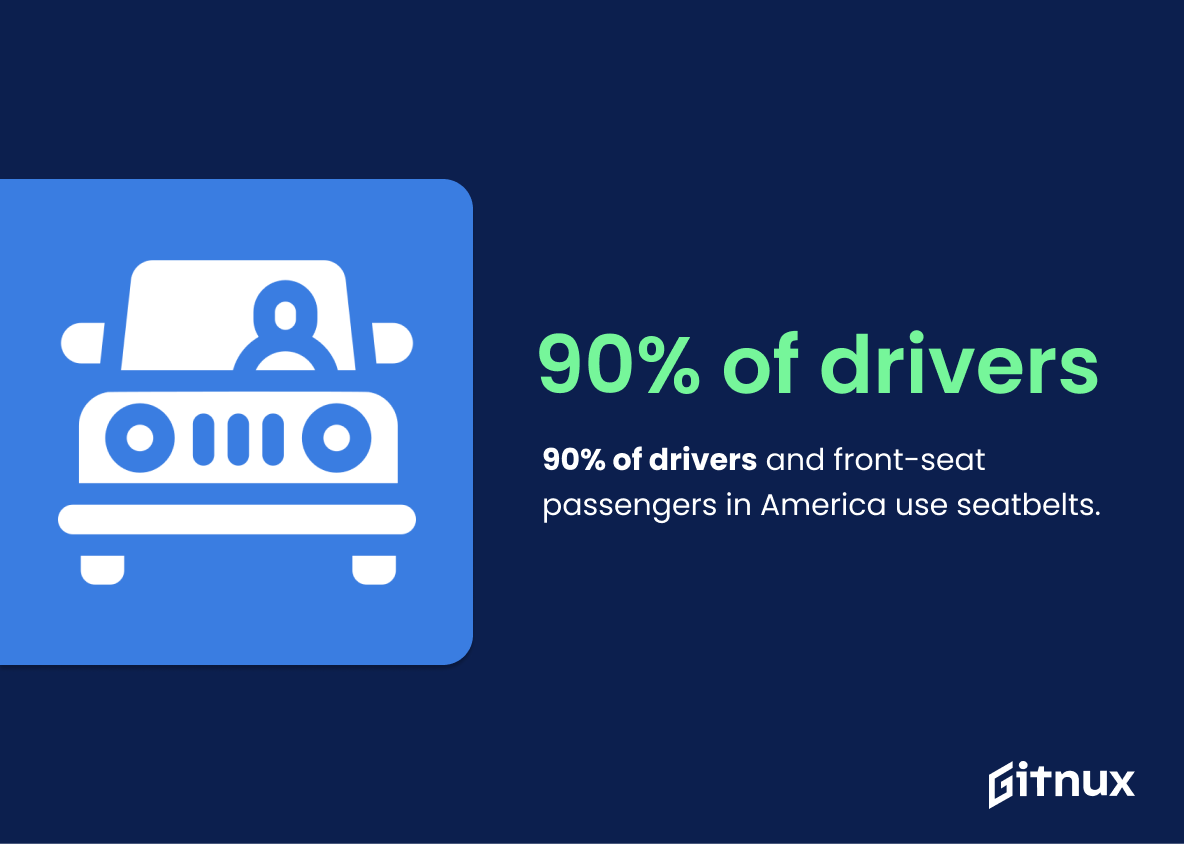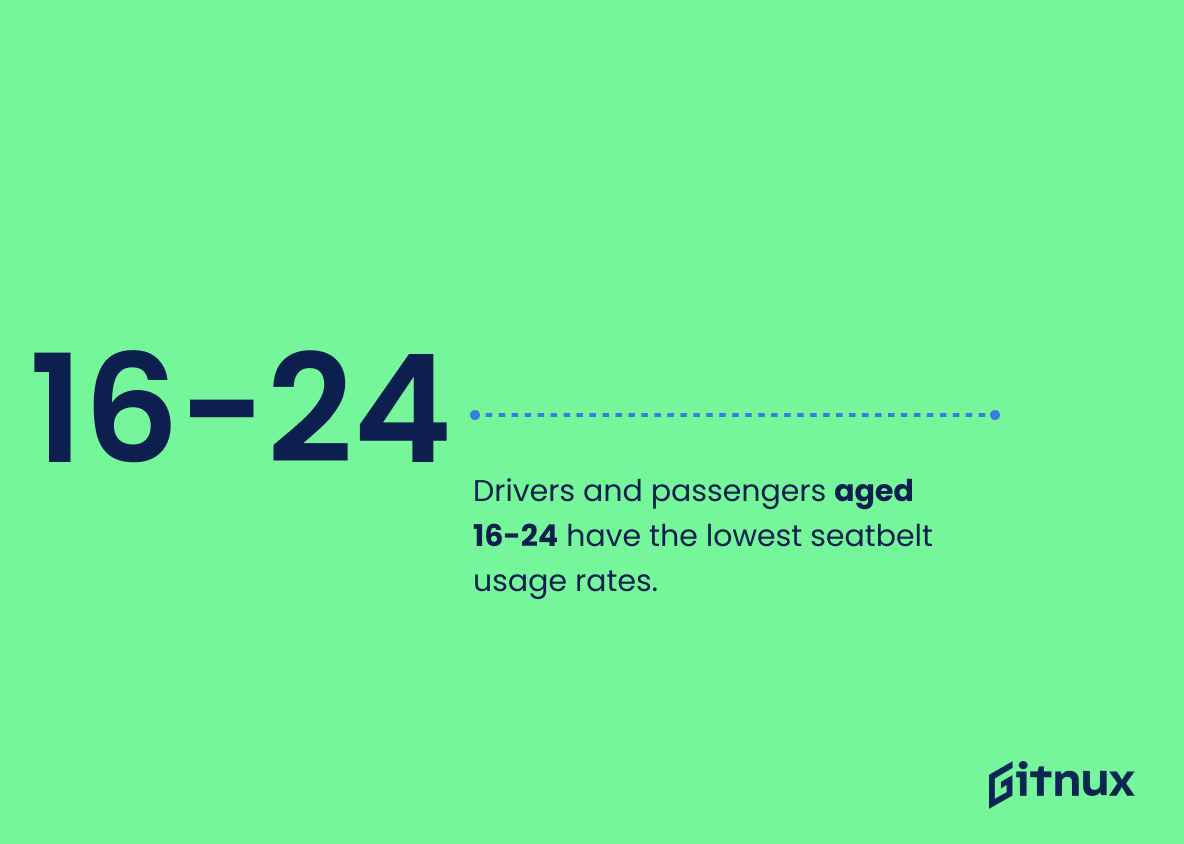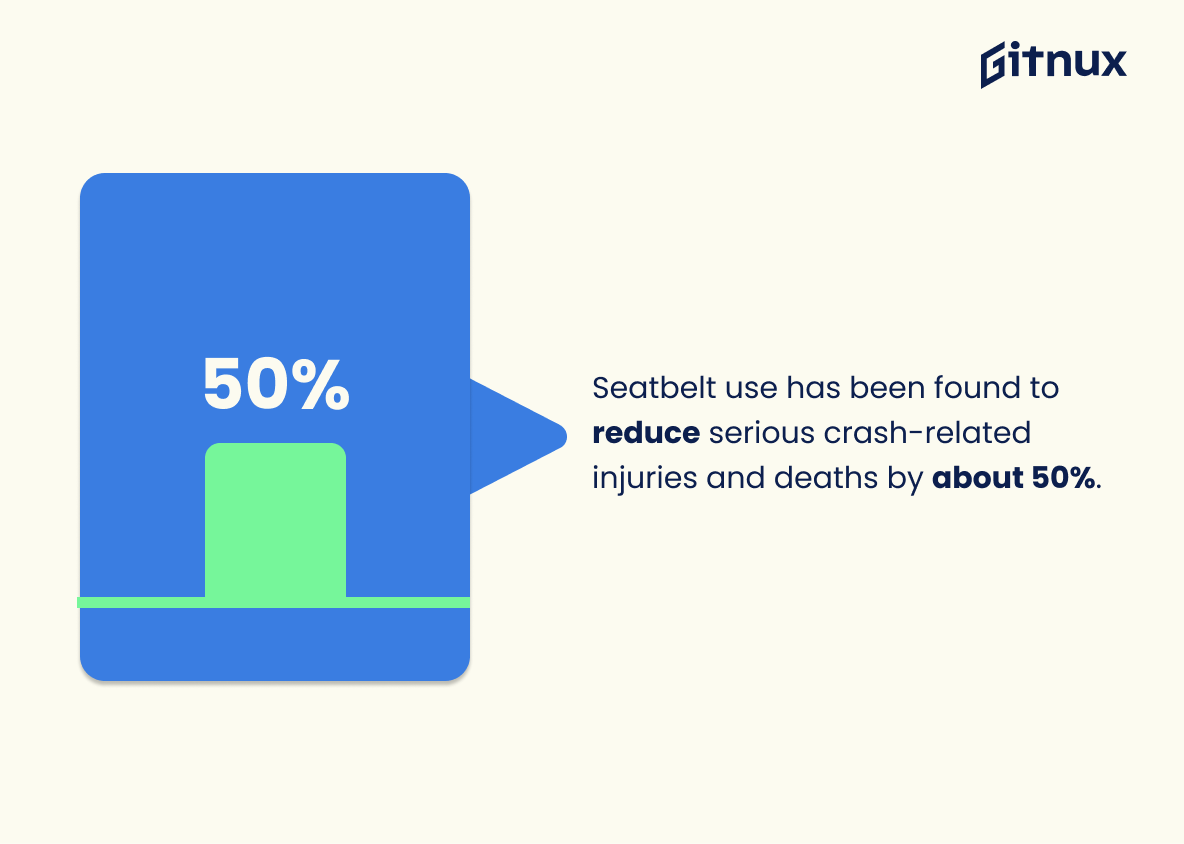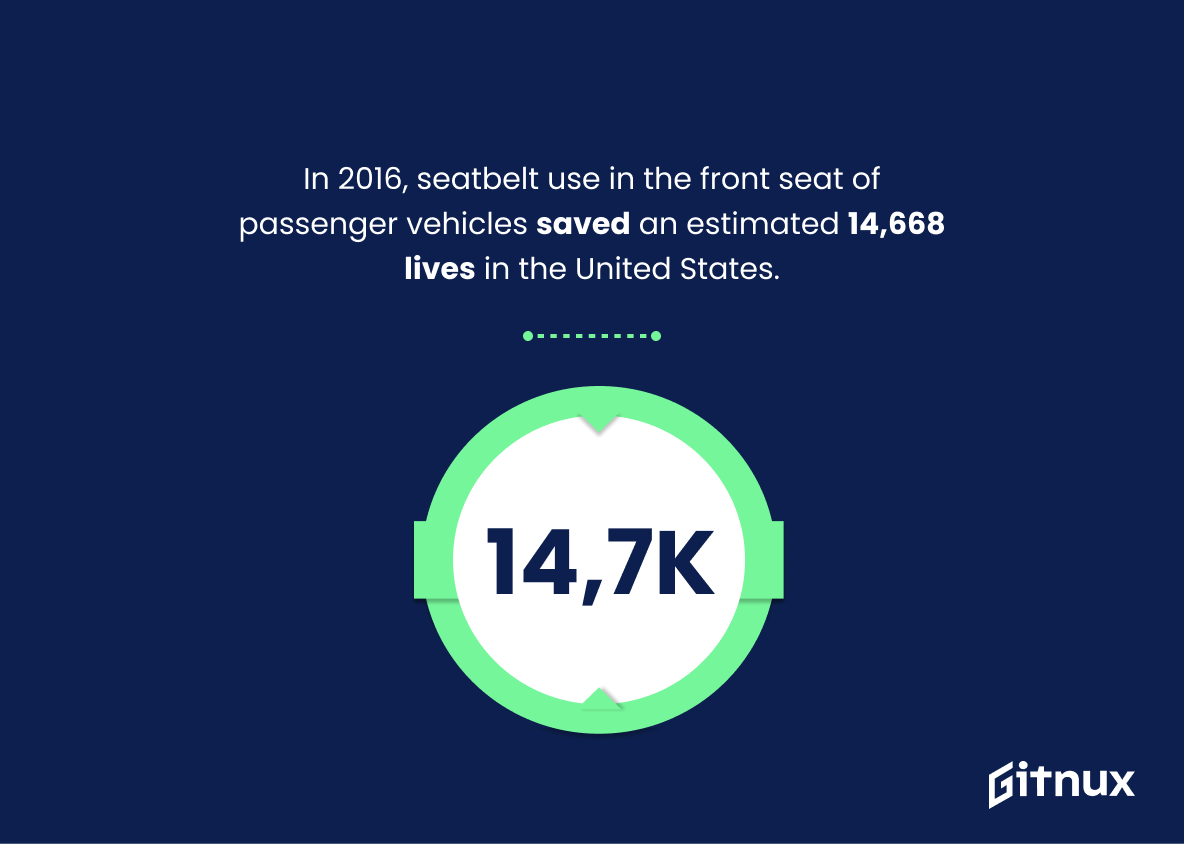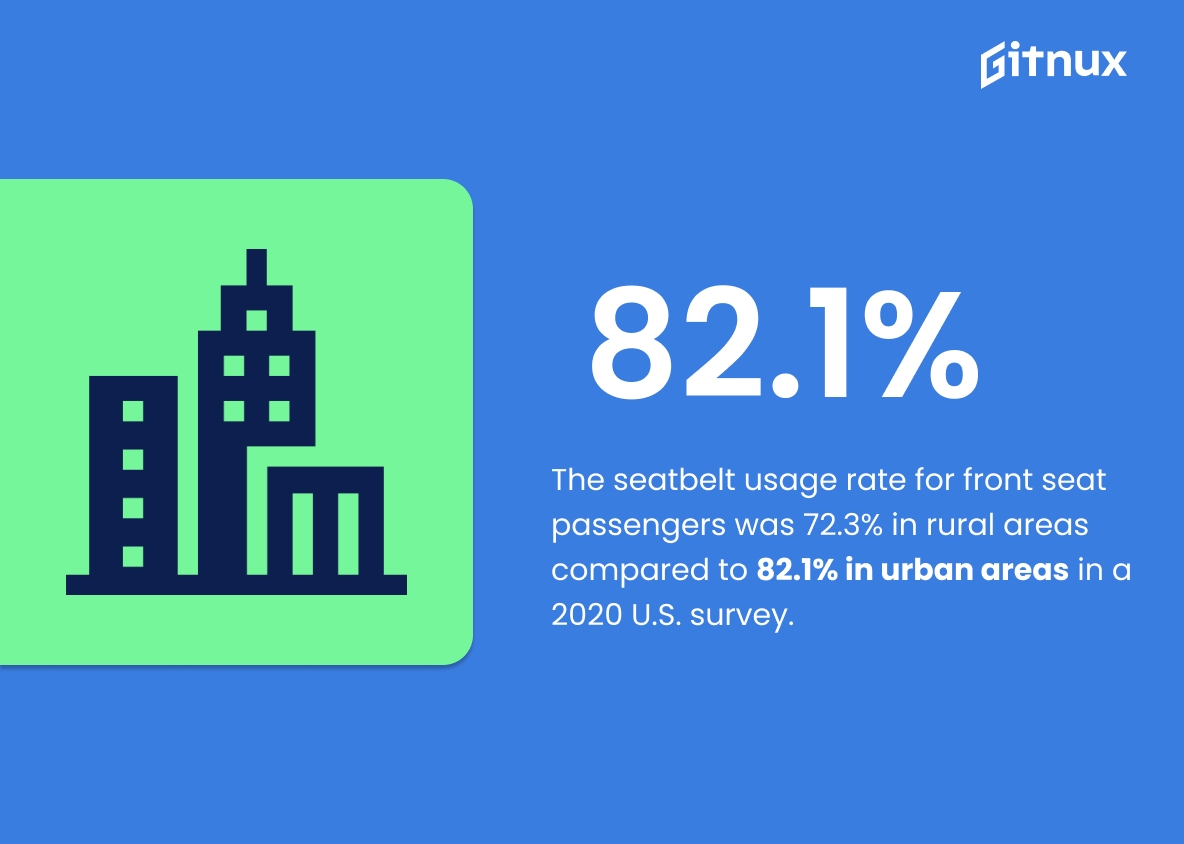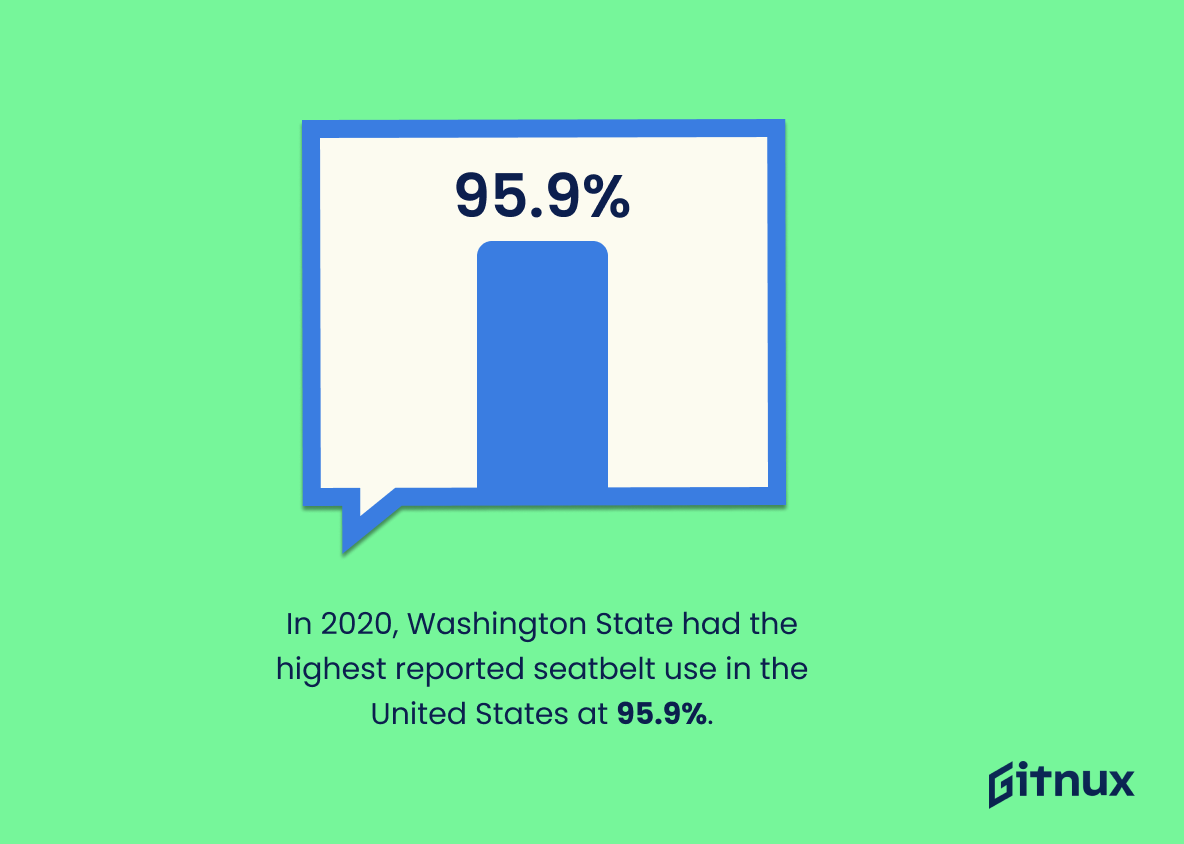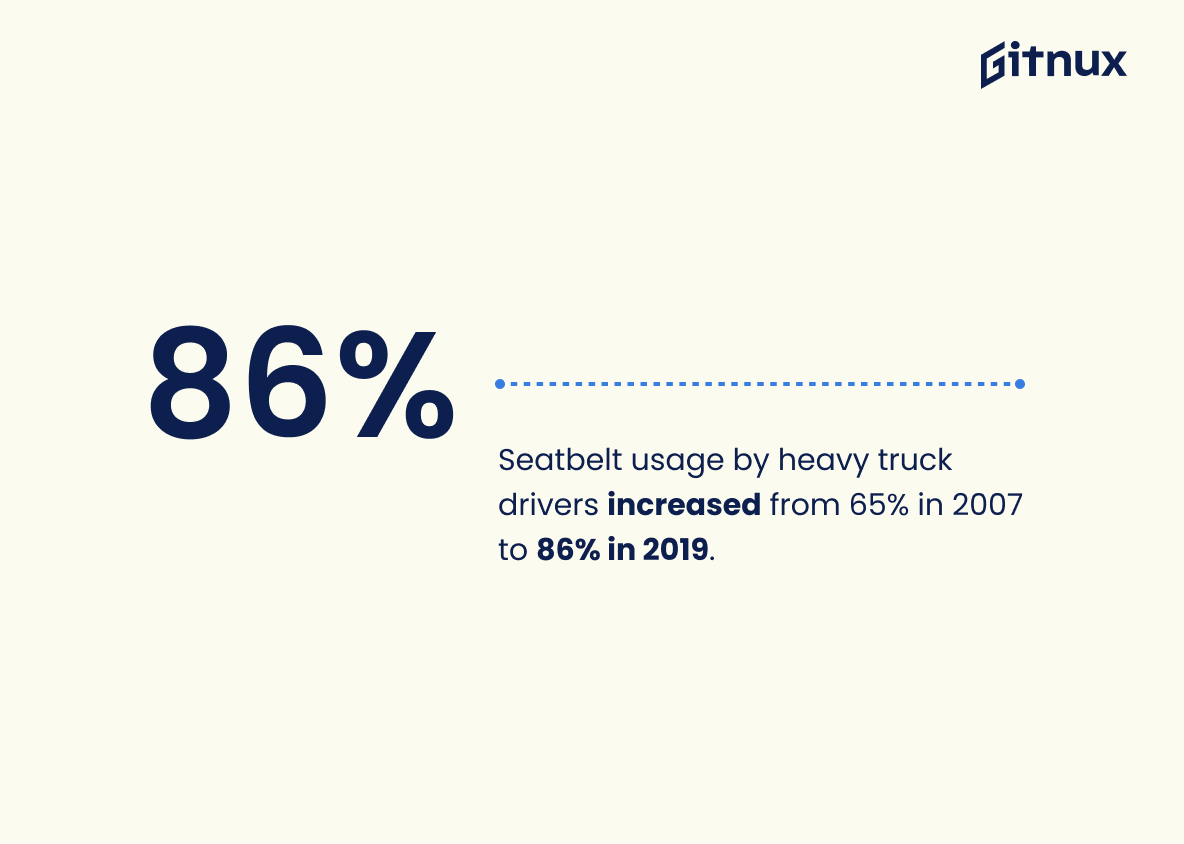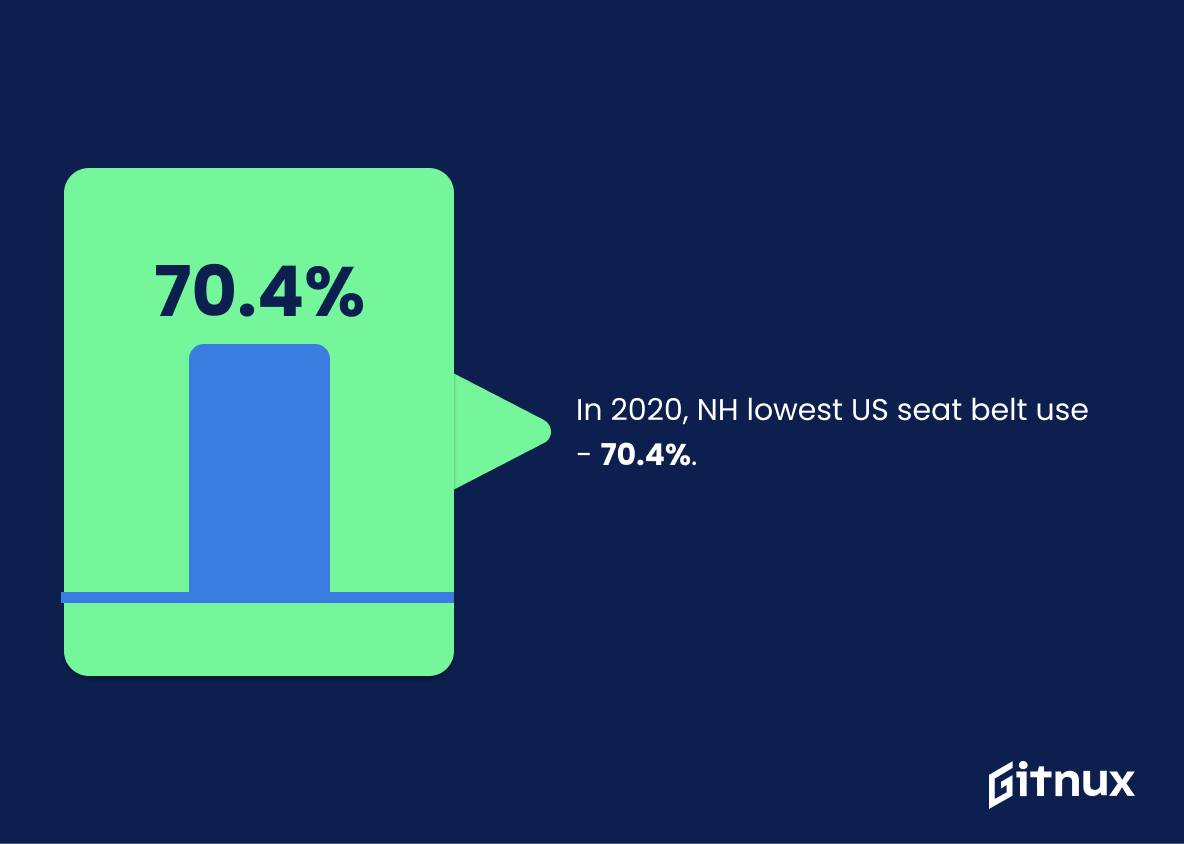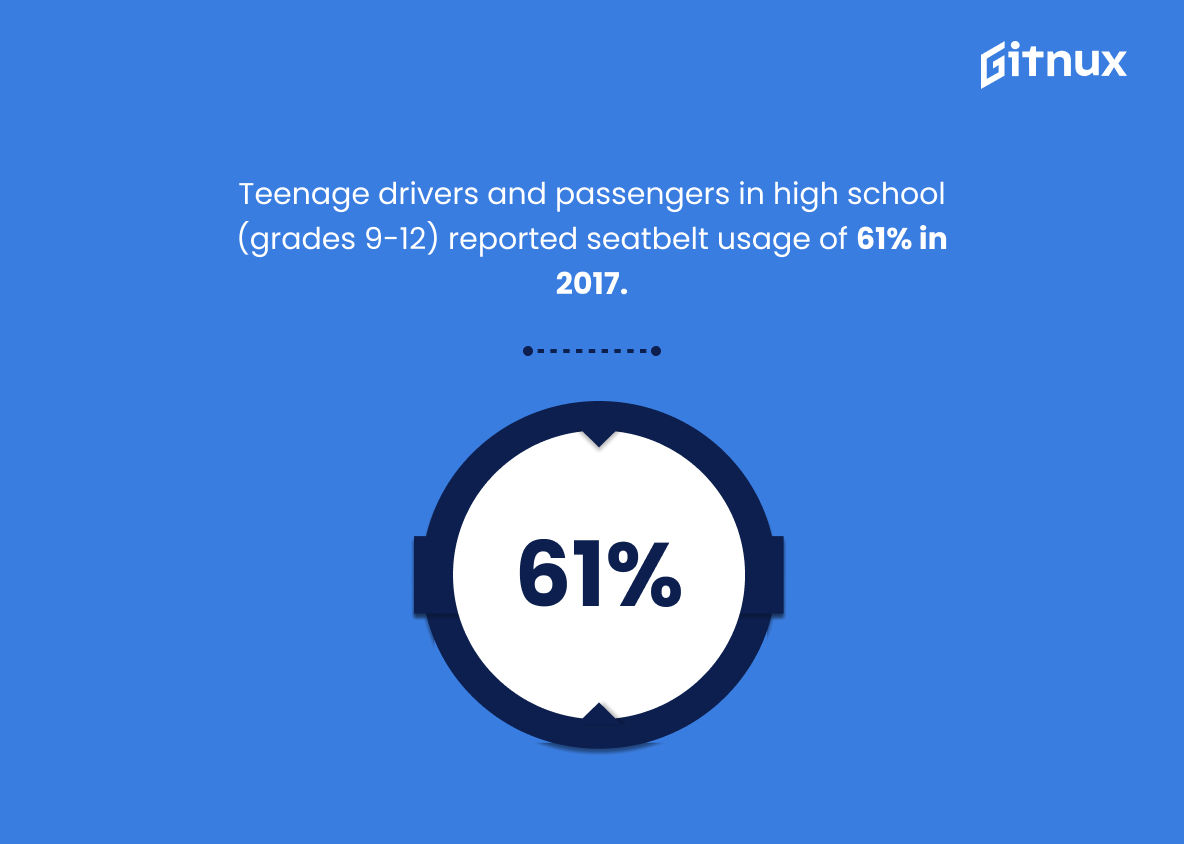Understanding the critical role of seatbelts in ensuring safe travel is paramount. When it comes to safety on the roads, a simple act of buckling up can often make a significant difference. Our exploration into seatbelt usage statistics offers a deep dive into the reality of this life-saving habit. This blog post unravels a wealth of valuable data, reflecting the real-world impact of seatbelt use on reducing traffic accident fatalities and injuries.
It shines a light on the current trends and patterns of seatbelt usage across different demographics and regions, offering compelling insights that underline the importance of this basic safety measure. So, fasten your seatbelt as we steer you through these crucial statistics – a journey that promises to be both enlightening and thought-provoking.
The Latest Seatbelt Usage Statistics Unveiled
90% of drivers and front-seat passengers in America use seatbelts.
In weaving the tale of seatbelt usage statistics, the fact that 90% of American drivers and front-seat passengers buckle up forms a compelling chapter. This figure imbues the narrative with the vivid colors of compliance and safety awareness, revealing a majority population committed to embracing safety protocols.
Undeniably, it provides substantial grist to the mill of practice over theory, painting a hopeful picture of risk mitigation on American roads. So gear up, for this statistic is the headlight illuminating the pathway of discourse in our blog post on Seatbelt Usage Statistics.
Seatbelt use in the United States has steadily increased from 58% in 1994 to 90.7% in 2019.
Highlighting the striking escalation in seatbelt usage from a mere 58% in 1994 to a noteworthy 90.7% in 2019 exhibits a victorious trajectory in the pursuit of enhancing road safety in the United States. This compelling number progression forms the backbone of our discussion, emphasizing the power of persistent safety campaigns and regulations.
The upswing in seatbelt usage paints a vivid picture of our society’s evolving consciousness toward personal safety, setting the stage for further exploration into the factors catalyzing this behavioral transformation and fostering a safer driving environment.
Drivers and passengers aged 16-24 have the lowest seatbelt usage rates.
The unveiling of this statistic, that drivers and passengers aged 16-24 have the lowest seatbelt usage rates, paints an alarming picture in the backdrop of our discussion on seatbelt usage statistics. What brings this into sharp focus is the reality that these younger drivers and passengers, in the prime of their lives, are disproportionately putting themselves at higher risk while on the road.
This data nugget indeed prompts us to delve deeper into understanding why this age group takes such risks and what measures can make a significant impact in increasing their seatbelt usage rate. Furthermore, addressing this fact can be used to spearhead educational campaigns aimed at younger audiences, potentially saving many lives and reducing injury rates.
Seatbelt use has been found to reduce serious crash-related injuries and deaths by about 50%.
Picture the striking contrast of a world with seatbelts and without. The stark reality represented by this statistic is like a virtual time machine, introducing us to an alternate reality where every second car crash victim might have walked away with minor bruises instead of serious injuries or fatal consequences.
In the mosaic of seatbelt usage statistics, this particular piece shines brightly with its critical importance. It provides an undeniable defense to the importance of wearing seatbelts and a potent arrow to quell any queries about their effectiveness. Imagine being a participant in a lottery where the odds are stacked 50% in your favour. Wouldn’t you rush to buy a ticket? This statistic places us all in this fortunate scenario, with seatbelts being our golden ticket to safety.
In the vast virtual landscape of a blog about seatbelt usage statistics, this statistic stands as a towering beacon, casting a potent light on the life-saving potential of seatbelts. It is an impactful herald, powerfully advocating for a simple habit that can make the difference between life and death.
In 2016, seatbelt use in the front seat of passenger vehicles saved an estimated 14,668 lives in the United States.
Painting this statistical portrait of seatbelt’s life-saving prowess, we vividly illustrate how pivotal their role was in 2016 alone. These numbers aren’t just randomly strewn together; they tell a story of 14,668 individuals who lived to see another day, all thanks to the simple act of clicking their seatbelt in place.
One could argue that each click is a commitment to safety, a silent pledge to make it home —and as this statistic boldly underscores, it’s a pledge that yielded phenomenal results in passenger vehicles across the United States. An examination of these life-affirming figures is paramount in our continuing conversation about the unequivocal importance of seatbelt usage.
The seatbelt usage rate for front seat passengers was 72.3% in rural areas compared to 82.1% in urban areas in a 2020 U.S. survey.
Highlighting the disparity in seatbelt usage between rural and urban areas, as seen in the 2020 U.S. survey, underscores an integral point of focus in the conversation about safety on the road. With a notable 9.8% difference, urban areas present a more encouraging picture for seatbelt adherence compared to their rural counterparts. As road safety advocates delve into seatbelt usage statistics, this differentiation raises stimulating questions that could potentially shape the direction of policy-making and public campaigns.
From this vantage point, the divergence not only reveals geographical nuances in road safety habits but also opens avenues for more detailed exploration. It invites biting curiosity – what underlying factors contribute to this rural-urban divergence? Could it be a divergence in safety education, law enforcement vigor, or prior accident rates? This statistic could lead to a more refined and region-specific approach in mobilizing efforts to increase seatbelt usage, ultimately aiming for safer roads nationwide.
In 2020, Washington State had the highest reported seatbelt use in the United States at 95.9%.
With the spotlight on Washington State, proudly wearing the crown for the highest recorded seatbelt usage in the United States at a noteworthy 95.9% in 2020, we delve into the world of seatbelt usage statistics. This sterling percentage is not only a shining achievement on the safety scoreboard but also a testament to the effectiveness of road safety awareness campaigns and stringent law enforcement.
By featuring this detail in our blog post, it brings home the fact that progress is achievable in the goal towards universal seatbelt usage, doing its part in saving lives and reducing the severity of injuries in road accidents. Moreover, it leaves other states with a tangible target to compete with and hopefully exceed, thereby increasing the safety of road-users across the entire nation.
Seatbelt usage by heavy truck drivers increased from 65% in 2007 to 86% in 2019.
Delving into the transformational journey of seatbelt usage by heavy truck drivers, it’s fascinating to uncover a laudable elevation from 65% in 2007 skyrocketing to 86% in 2019. This shift represents a telling tale of heightened safety consciousness, a triumph for advocacy efforts pushing for more stringent safety measures. By integrating this statistic into our discussion, we underline the importance we place not just on raw data, but on the lives these numbers represent.
This vividly captured upswing, as brought out by this statistic, lends substance and enlivens the narrative of our blog post on Seatbelt Usage Statistics; a testament to the power of safety norms in fundamentally altering behavior over time.
In 2020, New Hampshire had the lowest use of seat belts in the United States at only 70.4% of drivers and passengers using seat belts.
Spotlighting New Hampshire’s alarming record of seatbelt usage in 2020, puzzlingly the lowest in the United States at a mere 70.4%, serves as a profound wake-up call in our discussion on Seatbelt Usage Statistics. This sobering data, relegated to the icy underbelly of the study, demonstrates the tragic hesitance or perhaps reluctant disregard among drivers and passengers to prioritize their personal safety, thus perpetuating a cycle of preventable road accidents.
It underscores the life-saving urgency to amplify our public safety campaigns, seek stronger enforcement policies and explore effective strategies for habit change. In essence, the lingering image of this ‘Granite State’ anomaly should provoke, nay, demand a renewed commitment from one and all to ‘buckle up’, not just as a legal requirement but as a personal obligation for our well-being.
Teenage drivers and passengers in high school (grades 9-12) reported seatbelt usage of 61% in 2017.
The portrayal of a seemingly modest 61% seatbelt usage among teenage drivers and passengers in high school (grades 9-12) in 2017 provides a striking point of reflection in our discussion on seatbelt usage statistics. This numerical evidence sends a cautionary ripple, highlighting a grave shortcoming in teenage safety culture.
We are led to question the remaining 39% who possibly choose not to wear seatbelts, exposing themselves to substantial risk. This statistic emphasizes the necessity for more effective education and enforcement strategies, specifically targeted at this young and vulnerable demographic to increase their seatbelt usage. It signifies an urgent call to action, because every percentage point improvement could potentially save a life.
In 2017, men were 10% less likely than women to wear seatbelts.
Highlighting the 10% discrepancy in seatbelt usage between men and women in 2017 underscores a critical gender-based variation that stands as a point of discussion in our discourse on seatbelt usage statistics. By shedding light on this disparity, we set the stage for further exploration as to why such a difference exists, whether it pertains to risk perception, education, or enforcement of seatbelt laws. This nugget of information thus not only enriches our understanding of seatbelt usage patterns, but it also thrusts gender considerations into the limelight, compelling us to dig deeper and potentially unearth other interesting trends and correlations. It serves as a springboard for an expanded discussion on gender-specific safety precautions, the importance of wearing a seatbelt, and preventative measures to reduce the likelihood of traffic-related casualties – an information-rich backdrop for our ongoing conversation on seatbelt usage statistics.
Seatbelt use in Canada increased from 85.4% in 2003 to 95.2% in 2014.
Emerging from the data-laden corridors of statistics, a heroic figure springs up to claim the spotlight: the percentage of seatbelt use in Canada, which elevated from 85.4% in 2003 to a sterling 95.2% in 2014. This dramatic increase gestures not simply to an upward shift in numbers, but to a triumph for public safety, raising the curtain on a narrative of national behavioral change.
Consider the implications of this at a human level. Just over a decade witnessed a phenomenal change in habits, with nearly 10% more Canadians donning their seatbelts. These aren’t just numbers on a page, they’re lives potentially saved, they’re injuries possibly prevented.
Our blog post about seatbelt usage draws strength from this, illuminating how the culture of road safety in Canada is impressively evolving. Our statistic is a testament to the power of education, awareness campaigns, and legislation, showcasing how they can collectively steer the wheels of change, and help convert potential tragedies into stories of everyday precaution. It underlines that each seatbelt clicked is a step towards safer roads for all Canadians.
In Australia, seatbelt usage increased from 80% in 1982 to above 95% in 2010.
Capturing the fascinating journey of seatbelt usage, this Australian statistic serves as a triumphant testament to successful public safety campaigns. In the span of 28 years, seatbelt usage soared from 80% in 1982 to a commendable figure greater than 95% in 2010. Like a vivid diagram printed on the canvas of time, this statistic underscores the progress achieved by safety enforcements, awareness-raising initiatives, and the transformative power of collective responsibility.
This upward trend not only validates the efficacy of concerted efforts made in the Land Down Under, but also encapsulates the potential for significant change worldwide, making it a pivotal chapter in the broader narrative of seatbelt usage history.
Conclusion
In sum, the importance of seatbelt usage cannot be overemphasized. Statistics have repeatedly shown the dramatic effect they have on reducing fatalities and serious injuries in automobile accidents. A consistent application of this simple safety measure, by all vehicle occupants, would undoubtedly save thousands of lives each year and reduce the risk of injuries.
Governments, as well as individuals, have a vital role to play in promoting this life-saving habit. Seatbelts have proven to be highly effective and it is our collective responsibility to make their usage second nature.
References
0. – https://www.www.statista.com
1. – https://www.www.iihs.org
2. – https://www.www.nhtsa.gov
3. – https://www.www.roadsafety.transport.nsw.gov.au
4. – https://www.www.fmcsa.dot.gov
5. – https://www.www.cdc.gov
6. – https://www.www.ghsa.org
7. – https://www.www.bts.gov
8. – https://www.www150.statcan.gc.ca
